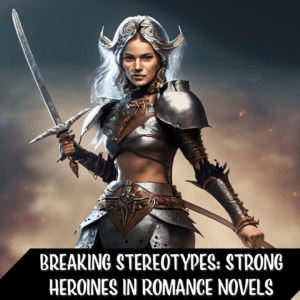Breaking Stereotypes: Strong Heroines in Romance Novels
 Romance stories have captivated readers for centuries, enchanting them with tales of love, passion, and heartfelt connections. Within this beloved genre, the portrayal of strong heroines has gained immense significance and has revolutionized the way readers engage with these narratives. No longer are heroines confined to the role of passive damsels in distress or mere love interests. Instead, they have emerged as powerful, independent protagonists who challenge stereotypes and inspire readers.
Romance stories have captivated readers for centuries, enchanting them with tales of love, passion, and heartfelt connections. Within this beloved genre, the portrayal of strong heroines has gained immense significance and has revolutionized the way readers engage with these narratives. No longer are heroines confined to the role of passive damsels in distress or mere love interests. Instead, they have emerged as powerful, independent protagonists who challenge stereotypes and inspire readers.
Today gender roles and expectations are being redefined. The representation of strong heroines in romance novels is both timely and essential. These heroines exemplify strength, resilience, and agency, serving as beacons of empowerment for readers of all backgrounds. By breaking away from traditional narratives, they encourage readers to question societal norms and envision a world where love and strength go hand in hand.
Defying Stereotypes: Unveiling Strong Heroines
Romance novels have undergone a remarkable transformation over the years, reflecting the changing societal attitudes toward women and their roles. In the past, female characters were often depicted as passive, dependent, and in need of rescuing. Contemporary romance literature has embraced a more progressive approach, presenting readers with strong, multifaceted heroines who defy stereotypes and embody empowerment.
Gone are the days of damsels in distress waiting for a hero to save them. Strong heroines take charge of their own destinies, facing challenges head-on and actively participating in their own stories. They possess inner strength, resilience, and the ability to overcome obstacles, showing readers that women are capable of shaping their own futures.
Strong heroines are not defined solely by their romantic relationships. They have dreams, aspirations, and passions beyond finding love. These characters pursue their goals, whether it’s a fulfilling career, personal growth, or making a difference in the world. By breaking away from the traditional love interest role, they inspire readers to prioritize their own dreams and aspirations.
Embracing Independence and Agency
Strong heroines embody independence and agency, making their own decisions and charting their own paths. They challenge societal expectations and norms, proving that women can be self-reliant, assertive, and capable of making choices that align with their values and desires. By embracing independence, they empower readers to embrace their own agency and make choices that reflect their true selves.
Readers form a deep emotional connection with strong heroines. These characters resonate with their struggles, dreams, and desires, eliciting empathy and understanding. By seeing themselves reflected in these empowered characters, readers feel seen, validated, and inspired to navigate their own lives with strength and resilience.
The presence of strong heroines in romance novels has a profound impact on readers, challenging and expanding their perceptions of gender roles and relationships. By witnessing these characters defy stereotypes and forge their own paths, readers are encouraged to question societal norms and embrace their own authenticity. Strong heroines serve as catalysts for critical thinking, empowering readers to challenge conventions and shape their own narratives.
Celebrating Diversity: Representing Strong Heroines
Romance novels have evolved to embrace cultural diversity, acknowledging the rich tapestry of experiences and backgrounds that exist in the real world. These stories now feature heroines from various cultural backgrounds, allowing readers to immerse themselves in narratives that reflect their own heritage or introduce them to new perspectives. By celebrating cultural diversity, romance novels broaden horizons and foster a greater sense of inclusivity.
Strong heroines in romance novels are not defined by a single dimension of their identity. Intersectionality plays a significant role in shaping these characters, as they navigate the intersection of race, ethnicity, gender, sexuality, and other aspects of their identity. This intersectionality adds depth and authenticity to their stories, highlighting the unique challenges they face and the strength they draw from their multiple identities.
Overcoming Adversity
Diverse heroines in romance novels often triumph over adversity, showcasing resilience and inspiring readers to face their own challenges head-on. Whether it’s overcoming cultural barriers, societal prejudices, or personal hardships, these heroines demonstrate the power of determination, courage, and inner strength.
Strong heroines in romance novels are not confined to traditional roles. They pursue their career goals and ambitions with passion and dedication. These characters break free from societal expectations and encourage readers to chase their own professional aspirations, fostering a sense of empowerment and fulfillment.
Embracing Non-Traditional Relationships
Romance novels featuring diverse heroines also explore non-traditional relationship dynamics. Whether it’s interracial relationships, same-sex romances, or unconventional partnerships, these stories challenge norms and broaden the representation of love and connection. By embracing non-traditional relationships, diverse heroines inspire readers to seek love and companionship on their own terms, regardless of societal expectations.
The Influence of Strong Heroines: A Social Perspective
Strong heroines in romance novels play help with shaping perceptions of gender roles in society. By showcasing women as capable, independent, and empowered individuals, these narratives challenge traditional gender norms and inspire readers to reconsider preconceived notions. The portrayal of strong heroines encourages society to recognize and appreciate the diverse abilities and strengths that women possess, fostering a more egalitarian mindset.
Empowering Women Outside the Realm of Fiction
The influence of strong heroines extends beyond the realm of fiction. These characters serve as powerful role models, inspiring women in real life to embrace their own strength, ambition, and agency. By witnessing strong heroines navigate challenges, pursue their dreams, and triumph over adversity, women are encouraged to break free from societal limitations and pursue their own paths to personal fulfillment and empowerment.
The impact of strong heroines in romance novels goes beyond the present generation. These characters inspire and shape the perspectives of future generations, providing a blueprint for what strong, independent women can achieve. Young readers who encounter these empowering narratives develop a sense of possibility, fueling their aspirations and fostering a belief in their own capabilities. The representation of strong heroines ensures that the legacy of empowerment continues to inspire and empower future readers.
Addressing the Male Readership
Strong heroines not only resonate with female readers but also have a significant impact on male readership. By showcasing women as equals, romance novels challenge traditional male-centric narratives and provide male readers with a fresh perspective on relationships, equality, and respect. The inclusion of strong heroines in romance stories encourages male readers to question and reconsider their own attitudes toward women, fostering empathy, understanding, and the dismantling of gender stereotypes.
Through the influence of strong heroines, romance novels have the power to shape society’s perception of gender roles, empower women in real life, inspire future generations, and promote equality among all readers.
Critiques and Challenges
While strong heroines in romance novels are celebrated for their empowerment, there is a delicate balance to strike between portraying strength and vulnerability. Critics argue that overly idealized portrayals of heroines can result in characters who seem invincible, lacking relatability and depth. It’s important to depict strong heroines as multidimensional individuals with flaws, vulnerabilities, and emotions, ensuring that readers can connect with their journey on a deeper, more authentic level.
Another critique faced by romance novels is the potential creation of unrealistic expectations in relationships. The portrayal of perfect heroines and idealized love stories can set unattainable standards, leading readers to compare their own lives to fictional narratives. Authors and readers alike must be mindful of distinguishing between the enchanting world of romance novels and the complexities of real-life relationships. Balancing the portrayal of extraordinary love with the realities of communication, compromise, and imperfections is crucial.
Romance novels have often faced criticism for being dismissed as mere “fluff” or lacking literary merit. These critiques fail to recognize the significant emotional and psychological impact these stories can have on readers. Romance novels provide a form of escapism, emotional catharsis, and empowerment. It’s important to address the criticism by highlighting the diverse themes, complex character development, and social relevance that exists within the genre.
Celebrating the Future: The Evolution Continues
Authors in the romance genre are driving the evolution of strong heroines. They’re at the forefront of creating narratives that challenge stereotypes, embrace diversity, and showcase the complexity of female characters. By weaving compelling stories with empowered heroines, authors inspire readers and shape the future of romance literature.
Reader Demand for Strong Heroines
The demand for strong heroines in romance novels continues to grow. Readers crave stories that empower and uplift, where they can see themselves reflected in the characters they admire. The desire for diverse, multidimensional heroines who defy stereotypes and navigate complex emotions resonates with readers across the globe. This reader demand encourages authors to create more inclusive and empowering narratives.
The presence of strong heroines has had a transformative impact on the romance genre. It has broadened the scope of storytelling, allowing for greater representation, exploration of diverse themes, and more dynamic relationships. Strong heroines have not only attracted a wider audience but have also pushed the boundaries of traditional romance narratives, paving the way for innovative subgenres and fresh perspectives.
As the romance genre continues to evolve, strong heroines will remain at the heart of its growth. Authors, driven by reader demand, will continue to craft narratives that empower and inspire. The impact of strong heroines extends beyond the pages of romance novels, influencing societal perceptions, challenging norms, and providing readers with a sense of possibility and empowerment.
It’s so important to support and encourage the continued celebration and recognition of strong heroines in romance novels. Authors, readers, and the publishing industry all have a role to play in championing diverse narratives, complex character development, and authentic representations. By embracing the evolution of strong heroines, we can ensure that the romance genre remains a powerful platform for empowerment, inspiration, and social change.
